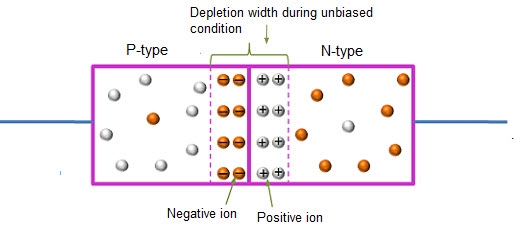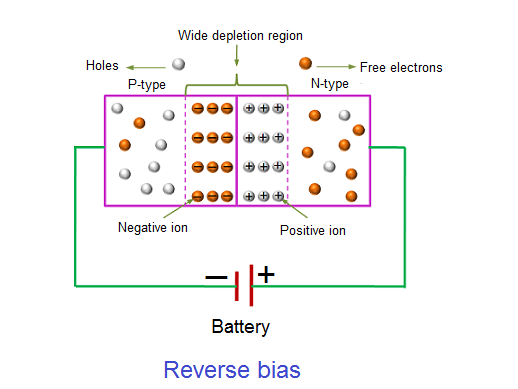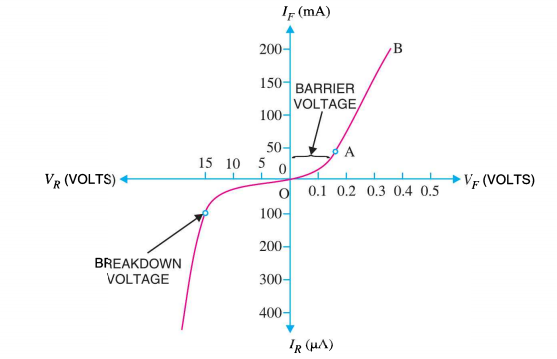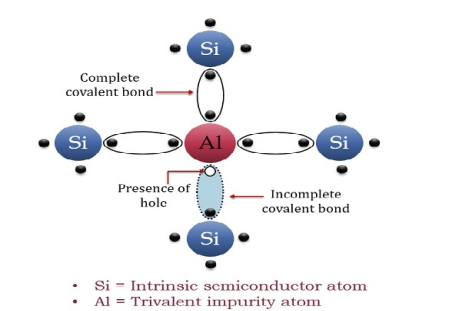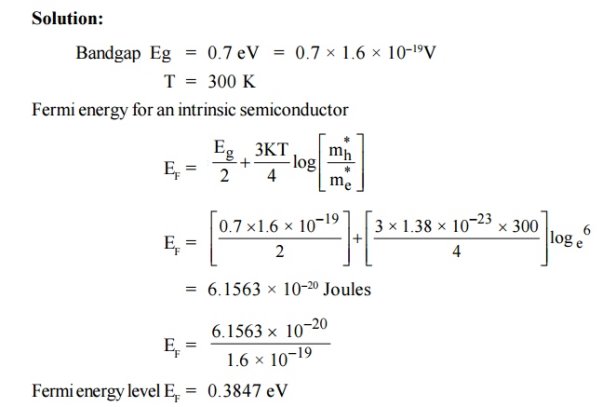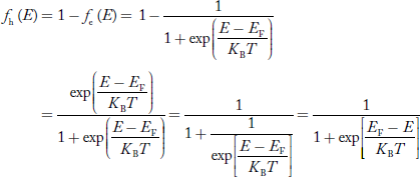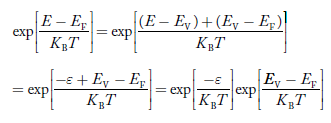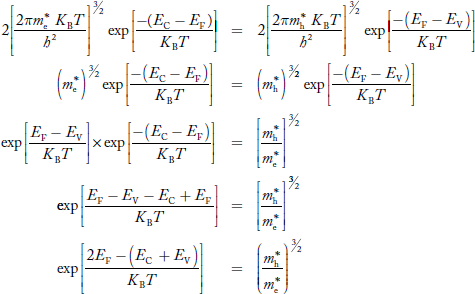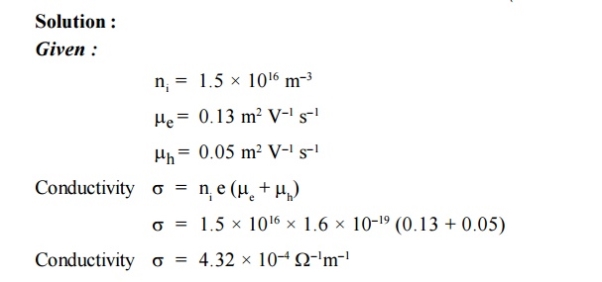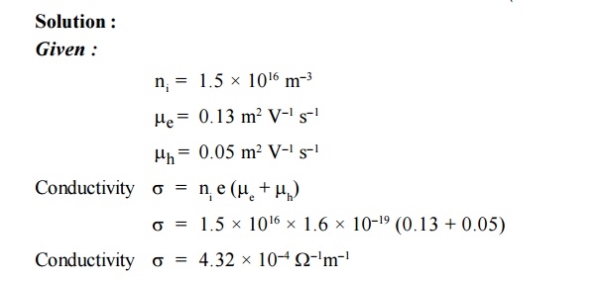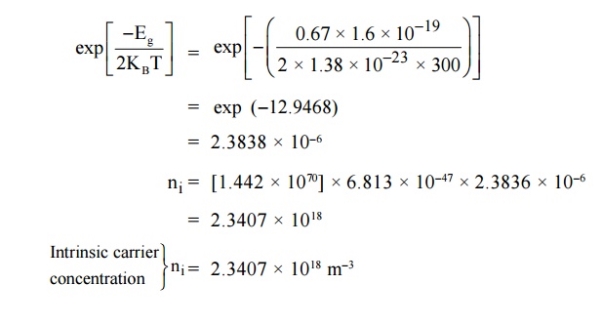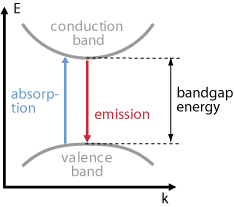Figure: Unbiased or zero biased PN Junction Diode |
Figure: Forward bias |
Figure: Reverse bias |
Figure: I-V characteristics |
|
|
|
|
|
|
|
|
|
|
The number of free electrons per unit volume of semiconductor having energies in between E and E + dE is represented as N(E) dE dE = width of Energy band Therefore, we have: N(E) dE = ge(E) dE fe(E) ……….(1) ge(E) = The density of electron states per unit volume fe(E) = Fermi-Dirac distribution function i.e. probability that an electron occupies an electron state The number of electrons present in the conduction band per unit volume of material ‘n’ is obtained by integrating N(E) dE between the limits Ec and Ect Where Ec = the bottom energy levels of conduction band Ect = the bottom and top energy levels of conduction band n = can be written as n = n = we know that above Ect, there is no electrons. Hence, Equation (3) becomes n = n = The Fermi-Dirac distribution function fe(E) can be represented as:
Compared to the exponential value, so the ‘1’ in the denominator can be neglected. So Hence, The density of electron states ge(E) in the energy space from E = 0 to E can be written as:
where me* is the effective mass of an electron and h is Planck’s constant.
To evaluate n, the density of states is counted from Ec, since the minimum energy state in conduction band is Ec. so eq (8) can become
Substituting Equations (6) and (9) in (4) gives n = n = The above equation can be simplified by the following substitution: Put ɛ = E − Ec ………… (11) So, dɛ = dE In Equation (11), Ec is constant, as we change the variable E to ε in Equation (10), the integral limits also change. In Equation (11), as E → Ec then ε → 0 and E → ∞, then ε also → ∞. the exponential term in Equation (10) becomes:
Substituting Equations (11) and (12) in (10), we get: n = n = Above integral (I) can be simplified by substitution. Put ε = x2 so that dɛ = 2x dx I = = = Substituting Equation (14) in (13) gives: n = n = n = n = The term n =Nc |
Therefore, we have: P(E) dE = gh(E) dE fh(E) ……….(17) dE = width of Energy band gh(E) = The density of holes states per unit volume fh(E) = Fermi-Dirac distribution function i.e. probability that an hole occupies an electron state The number of electrons present in the conduction band per unit volume of material ‘n’ is obtained by integrating P(E) dE between the limits Evb and EV where EV = the bottom energy levels of valence band Evb = the bottom and top energy levels of valence band The total number of holes present in the valence band per unit volume of material ‘p’ is obtained by integrating P(E) dE
Equation (18) can be represented as:
Now we know that below Evb no holes is present. Hence, Equation (19) becomes
We know hole can also be defined as absence of an electron. presence of a hole = the absence of an electron Hence, the Fermi-Dirac function of holes fh(E) in the valence band is:
Compared to exponential, the ‘1’ in the denominator is negligible, Hence,
The density of hole states between E and E + dE in valence band can be written similar to Equation (8.9) for electrons.
Where mh* is the effective mass of hole. Substituting Equations (21) and (22) in (20),
The above equation can be simplified by the substitution: Put ɛ = EV − E ............. (24) so dɛ = − dE In Equation (24), EV is constant, as we change the variable E to ε in Equation (23), the integral limits also change. In Equation (24), as E → EV then ε → 0 and E→ −∞, then ε → ∞ the exponential term in Equation (23) becomes:
Substituting Equations (24) and (25) in (23), we get:
From Equation (14), we know the integral value
….The term
|
|
|
 is very small so that EF is just lie in the middle of energy gap Temperature effect on Fermi levelFermi level slightly rises with increase of temperature.But in case of pure intrinsic semiconductor like Si and Ge, mh* ≈ me* so in these cases Fermi level lies at the middle of energy gap. Q9) Calculate the intrinsic concentration of charge carriers at 300 K given that m *e =0.12m o ,m *h =0.28mo and the value of brand gap = 0.67 eV. A9) Solution:
is very small so that EF is just lie in the middle of energy gap Temperature effect on Fermi levelFermi level slightly rises with increase of temperature.But in case of pure intrinsic semiconductor like Si and Ge, mh* ≈ me* so in these cases Fermi level lies at the middle of energy gap. Q9) Calculate the intrinsic concentration of charge carriers at 300 K given that m *e =0.12m o ,m *h =0.28mo and the value of brand gap = 0.67 eV. A9) Solution:
|
|
|
|
n = p N+D (Or) n ≈ N+D …………(38) [since p << N+D] |
|
So we can rewrite the above equation as nn ≈ ND …………….(39) where nn represents electrons in n-type material also the hole concentration in n-type material can be obtained by applying law of mass action nn pn =ni2
where pn represents holes concentration in n-type material. In n-type material at 0 K, the Fermi energy level lies in the middle of Ec and ED
At temperature> 0K
|
pp represents holes in p-type material np represents electrons in p-type material There are no donor atoms so means no ions present At 0 K, all the acceptor levels are not occupied by electrons. As the temperature is increased from 0 K, some electrons jump from top valence band energy levels to the acceptor states, leaving holes in the valence band and acceptor ions At some room temperature T K, concentration of conduction electrons is extremely less compared with hole concentration. ∴ From Equation (34), we have n + N−A = p ……………(42) (or) N−A ≈ p ……………. (43) [since n << N−A] At temperature T K, in p-type material, the hole concentration is almost equal to the acceptor atoms in unit volume of the material. So, Equation (43) can be written as pp ≈ NA ……………….(44) where pp represents holes in p-type material The electron concentration in p-type material can be obtained by applying law of mass action as nppp = ni2
where np represent free electron concentration in p-type material.
|
|
|
|
|
The relation between current density J and drift velocity vd is J = Nqvd Where N is the carrier concentration q is the charge of electron or hole From equations (1) and (2), we get Jdrift = Nq μE μ is the mobility of charge carrier. The above equation shows the general expression for drift current density. Drift current density due to electrons is Je(drift) = neμeE Where n is the electrons carrier concentration and μe is the mobility of electrons. Drift current density due to holes is Jh(drift) = peμhE Where p is the carrier concentration of holes. μh is the mobility of holes so Total drift current density Jdrift (total) = Je(drift) + Jh(drift) = neμeE + peμhE = eE (nμe+pμh ) |
Rate of diffusion of charge ∝ - = - D Where D is the diffusion coefficient of charge carriers. The negative sign indicates decrease of N with increase of x So, the diffusion current density Jdiffu is Jdiffu = - qD Where q is the charge of the charge carrier Diffusion current density due to holes is Jdiffu (hole) = - eDh |
Jdiffu (electrons) = eDe Jdiffu (total) = Jdiffu (hole) + Jdiffu (electrons) Jdiffu (total) = - eDh The expression for total current density due to holes is Jh (total) = Jh(drift) + Jdiffu (hole) = peμhE - eDh The expression for total current density due to electrons is Je (total) = Je(drift) + Jdiffu (electrons) = neμeE + eDe |
|
|
Figure: Band gap energy diagram |
Figure: Absorption or gain, spontaneous emission and stimulated emission.
|
Spontaneous emission | Stimulated emission |
1.The spontaneous emission was postulated by Bohr | 1.The stimulated emission was postulated by Einstein |
2. Additional photons are not required in spontaneous emission | 2. Additional photons are required in stimulated emission |
3.One photon is emitted in spontaneous emission | 3.Two photons are emitted in stimulated emission |
4.The emitted radiation is poly-monochromatic | 4.The emitted radiation is monochromatic |
5. The emitted radiation is Incoherent | 5. The emitted radiation is Coherent |
6. The emitted radiation is less intense | 6. The emitted radiation is high intense |
7.The emitted radiation has less directionality | 7.The emitted radiation has high directionality |
8. Example: light from sodium or mercury lamp | 8. Example: light from the laser source.
|
|
|
We have seen above that Stimulated absorption rate ∝ N1 i.e. Number of atoms in the ground state ∝ ρ(υ) i.e. Density of photons spontaneous emission
Stimulated absorption rate = B12N1ρ(υ) ………(1)
|
Spontaneous emission rate ∝ N2 i.e. number of atoms in the excited state Spontaneous emission rate = A21N2 ………(2) Where A21 is the Einstein coefficient of spontaneous emission. Stimulated emission rate depends upon the number of atoms available in the excited state as well as the energy density of photons. Stimulated emission rate ∝ N2 i.e. number of atoms in the excited state ∝ ρ(υ) i.e. Density of photons Stimulated emission rate = B21N2ρ(υ) ………(3)
|
if the system is in equilibrium the upward transitions must be equal to downward transitions. upward transitions = downward transitions B12N1ρ(υ) = A21N2 + B21N2ρ(υ) ………(4) B12N1ρ(υ) - B21N2ρ(υ) = A21N2 (B12N1- B21N2) ρ(υ) = A21N2 ρ(υ) = Divide with B21N2 in numerator and denominator in the right side of the above equation, ρ(υ) = ρ(υ) = We know from Maxwell Boltzmann distribution law
And also from Planck’s law, the radiation density ρ(υ) = Comparing the two equations (7) and (9)
The above relations are referred to as Einstein relations. From the above equation for non-degenerate energy levels, the stimulated emission rate is equal to the stimulated absorption rate at the equilibrium condition.
|
a) B12 > B21
b) B12 < B21
c) B12 = B21
d) No specific relation
A20)C is the correct answer.
B21 is the coefficient for the stimulated emission while B12 is the coefficient for stimulated absorption. Both the processes are mutually reverse processes and their probabilities are equal. Therefore, B12 = B21. Q21) What is Pumping? Discuss the various type of pumping mechanisms? A21)Solution: For laser action, the pumping mechanism (exciting with external source) maintain a higher population of atoms in the upper energy level relative to that in the lower level.A system in which population inversion is achieved is called an active system. The method of raising the particles from a lower energy state to a higher energy state is called pumping. The process of achieving population inversion is called pumping. This can be done in several ways. The most commonly used pumping methods are
